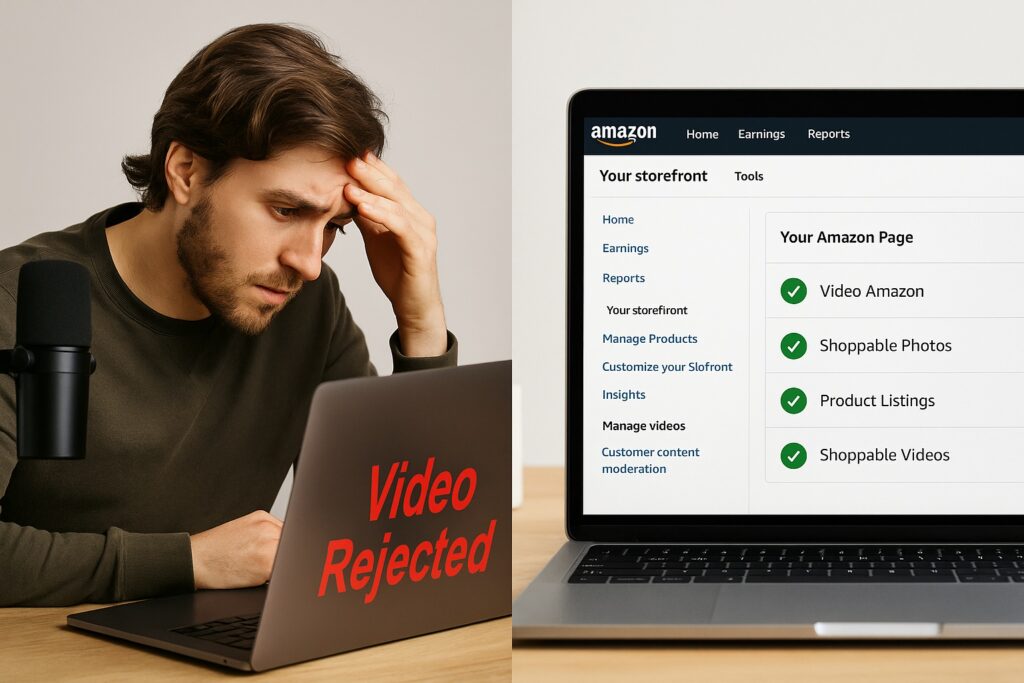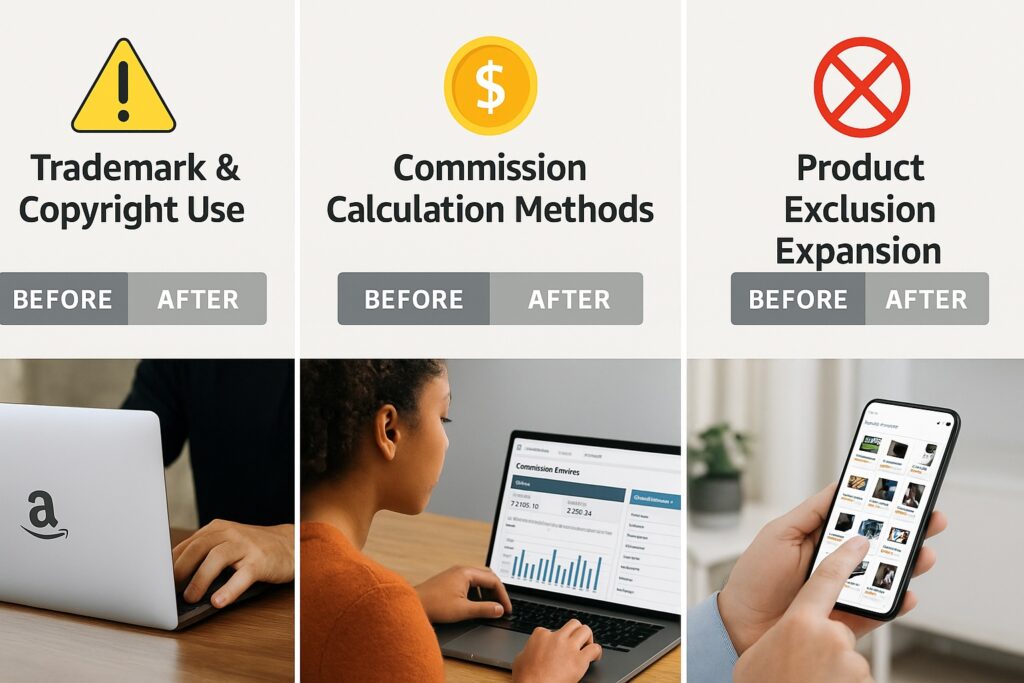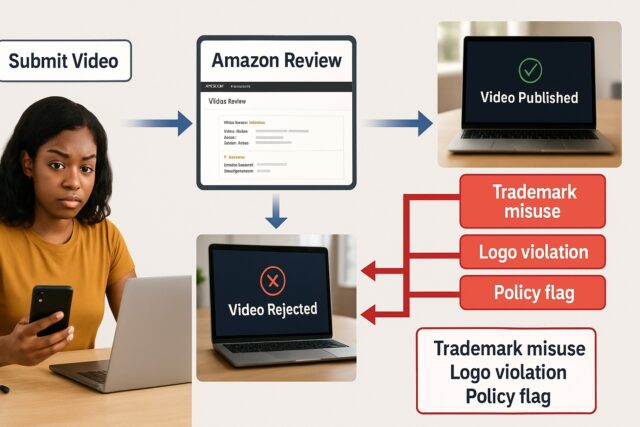If you’re an Amazon influencer, affiliate partner, or DTC brand running social commerce, the ground just shifted under your feet.
As we head into the busiest shopping season of the year, Amazon has rolled out a series of major updates to its Associates Program, and these changes are significant.
They touch everything from how you earn and what content qualifies, to the words and images you can legally use.
By the way, if you want to stay connected and know everything about social commerce and never miss a beat, join Logie today! Click here
For creators who depend on affiliate revenue, it’s a line in the sand between compliance and potential income loss.
Let’s unpack what changed, why it matters, and what you should do now to protect your storefront, your earnings, and your peace of mind.
1. The Big Three Policy Updates
Amazon’s new Associates Program Terms of Service sharpen the rules around intellectual property, commission calculations, and product eligibility.
The older version left many gray areas that creators and affiliates could navigate loosely, but this new update closes most of those gaps.
- Trademark and Copyright Use
Amazon is tightening the screws on how affiliates can use logos, brand imagery, and any reference that might imply endorsement.
Before, creators often used Amazon’s logos, cropped brand images, or UI screenshots freely in their videos, thumbnails, and storefront banners. Enforcement was spotty, and most creators never faced issues until now.
The new terms make it clear that only Amazon-approved marks may be used, exactly as provided, and without modification.
Even a slightly altered “smile” logo or the wrong shade of yellow could trigger content removal or account suspension.
For creators who build visually rich content, this will feel restrictive, but it’s intentional. Amazon aims to protect its trademarks and prevent creators from unintentionally implying that they represent or endorse the brand. It’s about control and brand consistency.

- Commission Calculation Methods
The second change directly impacts your bottom line. Amazon has adjusted how commissions are calculated, including new exclusions, redefined categories, and realignment of cookie windows.
That means the same content that earned well last month could now yield less or nothing at all.
Previously, there were ways to “stack” earnings or benefit from extended tracking periods through bonuses or campaign overlap.
Those options have been reduced or removed altogether. Certain product categories now fall outside commission eligibility, and bonuses are applied under much tighter conditions.
For creators who rely on seasonal gift guides, limited-time deals, or stacked bonuses, this could have a significant impact on total earnings. The only way to stay safe is to audit your commission reports on a weekly basis, not quarterly.
- Product and Category Exclusion Expansion
Finally, Amazon has expanded its list of ineligible products and categories, but the changes were not announced publicly. This quiet shift has caught many creators off guard.
A product that used to generate solid affiliate income can now be excluded overnight.
If your content features trending or high-traffic items from these categories, you may still drive thousands of clicks but you won’t see a cent from them.
It’s an invisible leak that can devastate revenue if you don’t regularly check your affiliate dashboard.
The new rules close loopholes, increase scrutiny, and demand that affiliates know exactly what qualifies for commission and what doesn’t.
2. Video Approvals and Storefront Compliance
While policy documents can seem abstract, the real-world consequences are showing up in creator workflows. The biggest pain point? Video and content rejections.
As Altovise Pelzer, highlighted during a recent community discussion:
“The reason why this was important, that I wanted to bring up was this could potentially be one of the reasons why some of our videos have been getting flagged… That could potentially be why some videos have gotten rejected.” Altovise Pelzer
This is exactly what’s happening now. Videos or posts that were previously approved are suddenly getting flagged for reasons that seem arbitrary but aren’t.
Many contain visual or verbal cues that violate Amazon’s tightened intellectual property rules.
Creators who don’t catch these issues early risk takedowns and delays in content publication during peak traffic windows, such as Black Friday or Cyber Monday.
When every hour counts, a flagged video can mean thousands of lost impressions and conversions.
Beyond video, entire storefronts are under stricter compliance audits. Amazon is now using more advanced detection systems to flag outdated product listings, disallowed trademarks, or expired affiliate links.
Storefronts that once “set and forget” their shoppable pages could now find them deactivated or hidden often without warning.

3. Impact on Affiliate Payouts
Creators are already reporting drops in commissions, unexplained payout discrepancies, or missing bonuses.
Some of these are due to policy exclusions; others are the byproduct of increased scrutiny over link compliance and IP violations.
If a high-performing video or storefront suddenly stops generating revenue, the cause might not be your audience or content quality it could be that the products you’re promoting have been quietly moved into the “ineligible” category.
It’s not dramatic to say that non-compliance now equals missed paychecks. The creators who stay vigilant, audit regularly, and adapt fastest will weather the shift while those who assume “everything still works” could lose their best earning season yet.
4. What Should Creators and Brands Do Now?
If you’re serious about protecting your Q4 earnings, this is your to-do list:
1. Audit Every Storefront and Link
Go through your top-performing videos, posts, and storefronts. Check that none of your promoted products fall under the newly excluded categories. Remove any unauthorized logos, brand marks, or phrases that might suggest endorsement.
2. Update Your Content Approval Workflow
Before you upload another video or carousel, run it through an internal compliance check. If you work with editors or assistants, make sure they understand the new rules. Even one incorrect logo overlay can cause a video to be flagged.
3. Monitor Commission Reports Closely
Don’t wait until the month’s end to discover a 20% drop in earnings. Check weekly and compare click-throughs against paid conversions. Sudden dips can signal that your links or categories have been disqualified.
4. Join Creator Communities
As these changes ripple across the affiliate world, community discussions are often the first place real insights surface. Join webinars, groups, and discussions with peers collective awareness is now your best defense.
5. Set Q4-Specific Alerts
Utilize affiliate monitoring tools to instantly flag broken or ineligible links. During high-traffic days like Black Friday and Cyber Monday, this can save you from losing thousands in potential commissions.
5. Takeaways
For many, these changes feel restrictive even frustrating. But viewed strategically, compliance has become a competitive edge.
Creators who adapt quickly, audit smarter, and stay compliant will not only avoid rejected videos but will also position themselves as reliable partners to brands.
When chaos hits the ecosystem (and it will), your storefront’s stability will become your superpower.
Amazon’s goal here is control but for creators, the hidden opportunity is clarity. The new rules, while strict, outline exactly what works and what doesn’t. And that knowledge is power.
So act now:
- Run a compliance sweep of your storefront this week.
- Scrub all new content for prohibited visuals and language.
- Stay connected with other creators to share real-time updates.
Q4 is simply too important to leave to chance or slow audits. Make compliance your secret weapon for the biggest sales season of the year.











